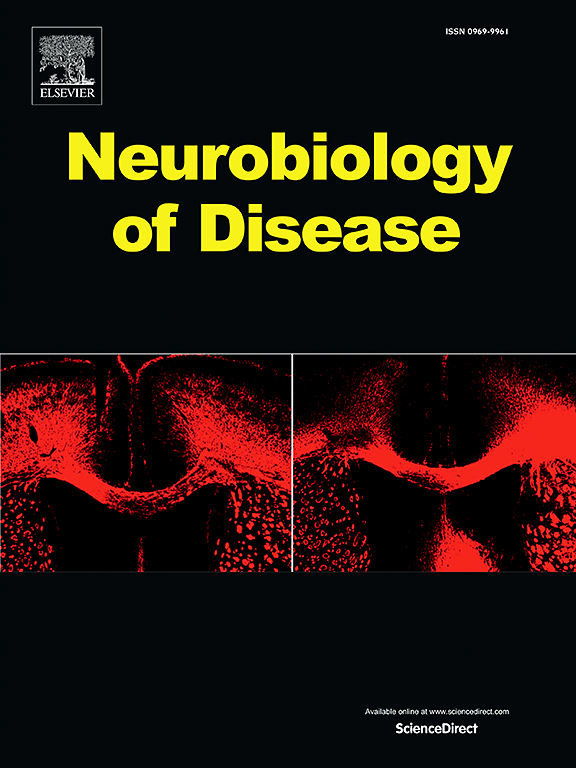A novel stable transgenic zebrafish line expressing mCherry-tagged human alpha-synuclein in the nervous system and exhibiting all the key features of Lewy body disorders at larval stage
IF 5.1
2区 医学
Q1 NEUROSCIENCES
引用次数: 0
Abstract
Lewy Bodies, proteinaceous inclusions containing α-Synuclein fibrillary aggregates, are defining neuropathological hallmarks of Parkinson's disease and Dementia with Lewy Bodies. Recently, zebrafish arose as a valuable model to study neurodegenerative diseases, but despite attempts to generate stable human α-Synuclein transgenic zebrafish lines recapitulating the main phenotypic characteristics of Lewy Body disorders, i.e., α-Synuclein fibrillary aggregate deposition, neurodegeneration and behavioral deficits, none of the models produced so far could develop all these features. Here, we describe the generation of a novel transgenic zebrafish line stably expressing human α-Synuclein in the nervous system and developing all the key Parkinson's Disease phenotypic traits during larval stage, named Tg(elavl3:mCherry-hsa.SNCA). By behavioral studies, molecular biology analysis, confocal and light-sheet fluorescence microscopy we found that Tg(elavl3:mCherry-hsa.SNCA) larvae developed basal motility deficits and anxiety traits as well as a significant increase of brain apoptotic cells in parallel with marked reduction of tyrosine hydroxylase-immunopositivity in forebrain regions at 5 days post fertilization. The Tg(elavl3:mCherry-hsa.SNCA) larvae accumulated Thioflavin-S-positive and high molecular weight serine-129-phosphorylated α-Synuclein. Furthermore, they displayed other typical pathologic alterations associated with Parkinson's Disease and Dementia with Lewy Bodies, such as accumulation of synapsins and changes in key autophagy markers. These findings, coupled with the suitability of larval zebrafish for high-throughput screening, support that the novel Tg(elavl3:mCherry-hsa.SNCA) line constitutes the first stable zebrafish experimental model for rapid and reliable studies addressing both the molecular basis of Lewy body disorders and the efficacy of new therapeutic approaches.

一种新的稳定的转基因斑马鱼系,在神经系统中表达mccherry标记的人α -突触核蛋白,并在幼虫期表现出路易体疾病的所有关键特征。
路易体是含有α-突触核蛋白原纤维聚集体的蛋白包涵体,是帕金森病和路易体痴呆的神经病理学标志。近年来,斑马鱼成为研究神经退行性疾病的一个有价值的模型,但尽管试图产生稳定的人α-突触核蛋白转基因斑马鱼系,再现路易体疾病的主要表型特征,即α-突触核蛋白原纤维聚集体沉积、神经变性和行为缺陷,但迄今为止所产生的模型都无法具备所有这些特征。在这里,我们描述了一种新的转基因斑马鱼系的产生,该系在神经系统中稳定表达人α-突触核蛋白,并在幼虫期发育出帕金森病的所有关键表型特征,命名为Tg(elavl3:mCherry-hsa.SNCA)。通过行为研究、分子生物学分析、共聚焦和光片荧光显微镜观察发现,Tg(elavl3:mCherry-hsa.SNCA)幼虫在受精后5 天出现了基础运动障碍和焦虑特征,脑凋亡细胞显著增加,前脑区域酪氨酸羟化酶免疫阳性显著降低。Tg(elavl3:mCherry-hsa.SNCA)幼虫积累了硫黄素- s阳性和高分子量丝氨酸-129磷酸化的α-突触核蛋白。此外,它们还表现出与帕金森病和路易体痴呆相关的其他典型病理变化,如突触的积累和关键自噬标志物的变化。这些发现,再加上斑马鱼幼虫适合高通量筛选,支持新的Tg(elavl3:mCherry-hsa.SNCA)系构成了第一个稳定的斑马鱼实验模型,可以快速可靠地研究路易体疾病的分子基础和新治疗方法的疗效。
本文章由计算机程序翻译,如有差异,请以英文原文为准。
求助全文
约1分钟内获得全文
求助全文
来源期刊

Neurobiology of Disease
医学-神经科学
CiteScore
11.20
自引率
3.30%
发文量
270
审稿时长
76 days
期刊介绍:
Neurobiology of Disease is a major international journal at the interface between basic and clinical neuroscience. The journal provides a forum for the publication of top quality research papers on: molecular and cellular definitions of disease mechanisms, the neural systems and underpinning behavioral disorders, the genetics of inherited neurological and psychiatric diseases, nervous system aging, and findings relevant to the development of new therapies.
 求助内容:
求助内容: 应助结果提醒方式:
应助结果提醒方式:


